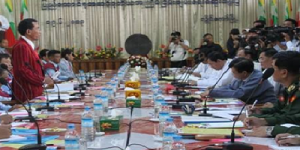
The ethnic groups that comprise Karenni State have suffered from a long history of conflict. The ongoing ceasefire talks will hopefully bring forth a peace process and an end to this suffering, but this is not the first ceasefire in the 66 year conflict and Karenni people know, now, more than ever that their hopes of returning to their homeland can be easily dashed.
The history of the Karenni provides context for the conflict and the current negotiations. The Karenni were previously granted independence in 1875, according to an agreement between the Burmese government and the British colonial administration.
After World War II, the Karenni were invited to join the union of Burma but they refused citing their long history as an independent state. In 1947, the father of Burmese independence, General Aung San was assassinated. Following this, U Nu took power in Burma and he encouraged Karenni State to be written into the constitution as a constituent part of the union.
After Karenni State was written into the constitution, without their leader’s consent, they continued to refuse to join the union. Due to these refusals, the Burmese Army invaded Karenni State in August, 1948. The Karenni resistance movement soon formed to counter this invasion and the conflict had begun.
Since the conflict’s beginning, the Karenni people have suffered many abuses by successive governments and dictators. These include Ne Win, SLORC (The State Law and Order Restoration Council) and currently, the SPDC government (The State Peace and Development Council).
The current ceasefire began on the 6th March 2012. The impetus on the talks, following this, have been to create a nationwide ceasefire for the whole of Burma. This is a feat that has not been accomplished in over 60 years. There was a previous ceasefire in Karenni State in 1995 but this broke down after three months. The break down caused serious fighting.
Now, Karenni people reside all across the world. There are large populations of Karenni people who have resettled in The USA, Finland and Australia. Additionally, there are about 20,000 Karenni refugees living along the Thai Burma border in Karenni Refugee Camps 1 and 2. Other Karenni people remain internally displaced within Burma. The Karenni community across the world is hoping that this round of ceasefire talks can finally bring peace for their homeland and their people.
